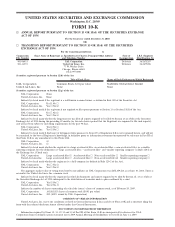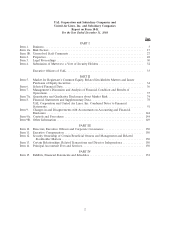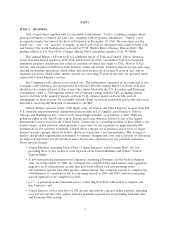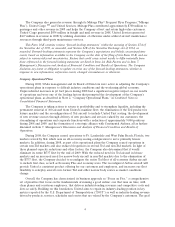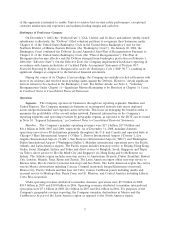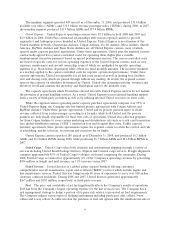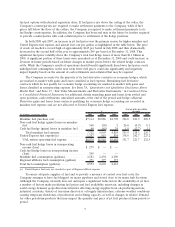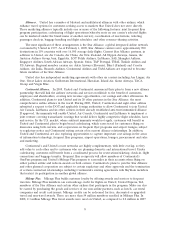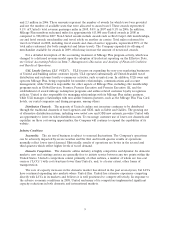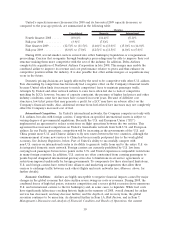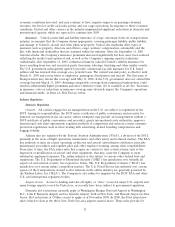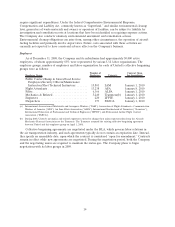United Airlines 2008 Annual Report Download - page 5
Download and view the complete annual report
Please find page 5 of the 2008 United Airlines annual report below. You can navigate through the pages in the report by either clicking on the pages listed below, or by using the keyword search tool below to find specific information within the annual report.of this approach is intended to enable United to achieve best-in-class safety performance, exceptional
customer satisfaction and experience and industry-leading margin and cash flow.
Bankruptcy of Predecessor Company
On December 9, 2002 (the “Petition Date”), UAL, United, and 26 direct and indirect wholly-owned
subsidiaries (collectively, the “Debtors”) filed voluntary petitions to reorganize their businesses under
Chapter 11 of the United States Bankruptcy Code in the United States Bankruptcy Court for the
Northern District of Illinois, Eastern Division (the “Bankruptcy Court”). On January 20, 2006, the
Bankruptcy Court confirmed the Debtors’ Second Amended Joint Plan of Reorganization Pursuant to
Chapter 11 of the United States Bankruptcy Code (the “Plan of Reorganization”). The Plan of
Reorganization became effective and the Debtors emerged from bankruptcy protection on February 1,
2006 (the “Effective Date”). On the Effective Date, the Company implemented fresh-start reporting in
accordance with American Institute of Certified Public Accountants’ Statement of Position 90-7,
Financial Reporting by Entities in Reorganization under the Bankruptcy Code (“SOP 90-7”), resulting in
significant changes as compared to the historical financial statements.
During the course of its Chapter 11 proceedings, the Company successfully reached settlements with
most of its creditors and resolved most pending claims against the Debtors. However, certain significant
matters remain to be resolved in the Bankruptcy Court. For further details, see Note 4, “Voluntary
Reorganization Under Chapter 11—Significant Matters Remaining to be Resolved in Chapter 11 Cases,”
in Combined Notes to Consolidated Financial Statements.
Operations
Segments. The Company operates its businesses through two reporting segments: Mainline and
United Express. The Company manages its business as an integrated network with assets deployed
across integrated mainline and regional carrier networks. This focus on managing the business seeks to
maximize the profitability of the overall airline network. Financial information on the Company’s
reporting segments and operating revenues by geographic regions, as reported to the DOT, can be found
in Note 10, “Segment Information,” in Combined Notes to Consolidated Financial Statements.
Mainline. The Company’s mainline operating revenues were $17.1 billion, $17.0 billion and
$16.4 billion in 2008, 2007 and 2006, respectively. As of December 31, 2008, mainline domestic
operations served over 80 destinations primarily throughout the U.S. and Canada and operated hubs at
Chicago O’Hare International Airport (“O’Hare”), Denver International Airport (“Denver”), Los
Angeles International Airport (“LAX”), San Francisco International Airport (“SFO”) and Washington
Dulles International Airport (“Washington Dulles”). Mainline international operations serve the Pacific,
Atlantic and Latin America regions. The Pacific region includes non-stop service to Beijing, Hong Kong,
Osaka, Seoul, Shanghai, Sydney and Tokyo and direct service to Bangkok, Seoul, Singapore and Taipei
via Tokyo; direct service to Ho Chi Minh City and Singapore via Hong Kong and to Melbourne via
Sydney. The Atlantic region includes non-stop service to Amsterdam, Brussels, Dubai, Frankfurt, Kuwait
City, London, Munich, Paris, Rome and Zurich. The Latin American region offers non-stop service to
Buenos Aires, Rio de Janeiro (seasonal non-stop) and Sao Paulo. The Latin American region also serves
various Mexico destinations including Cancun, Cozumel (seasonal), Ixtapa/Zihuatanejo (seasonal),
Mexico City, Puerto Vallarta and San Jose del Cabo; various Caribbean points including Aruba and
seasonal service to Montego Bay, Punta Cana, and St. Maarten; and Central America including Liberia,
Costa Rica (seasonal).
UAL’s operating revenues attributed to mainline domestic operations were $9.7 billion in 2008,
$10.9 billion in 2007 and $10.0 billion in 2006. Operating revenues attributed to mainline international
operations were $7.4 billion in 2008, $6.1 billion in 2007 and $6.4 billion in 2006. For purposes of the
Company’s geographic revenue reporting, the Company considers destinations in Mexico and the
Caribbean to be part of the Latin America region as opposed to the North America region.
5

